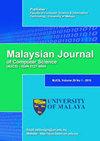GENETIC ALGORITHM - OPTIMIZED GATED RECURRENT UNIT (GRU) NETWORK FOR SEMANTIC WEB SERVICES CLASSIFICATION
IF 1.2
4区 计算机科学
Q4 COMPUTER SCIENCE, ARTIFICIAL INTELLIGENCE
引用次数: 1
Abstract
In the current era, as there is an abundant expansion of functionally similar web services, it becomes a prodigious issue for the web service discovery process. The service classification plays a significant role to greatly reduce the search space and retrieves the desirable service quickly and accurately. The classification is performed using the functional values. Recent research activities recommend RNN (Recurrent Neural Network) deep learning algorithms for efficient classification process. The state-of-the-art of GRU (Gated Recurrent Unit) one of the RNN model, provides a proficient classification process. However, the ratio of training and testing dataset, and hyperparameters namely neural network size, and batch size etc, affects the classification accuracy. The objective of the paper is to incorporate GRU model for efficient classification process. The novelty of the proposed model lies in implementing the GRU model for semantic web service classification. Furthermore, the genetic algorithm is used to predict the optimal ratio of training and testing dataset and optimal hidden neural Network units of GRU model in order to attain optimal classification. The experimental results exemplifies that the semantic web service classification is efficiently deliberated using the proposed GA-GRU model that outperforms the classification process as compared with the conventional semantic extraction using accuracy, precision, F-measure, recall and FDR (False Date Rate) rate.基于遗传算法优化的门控递归单元网络用于语义WEB服务分类
在当前时代,随着功能相似的web服务的大量扩展,它成为web服务发现过程中的一个巨大问题。服务分类在极大地减少搜索空间、快速准确地检索所需服务方面发挥着重要作用。使用函数值进行分类。最近的研究活动推荐了用于高效分类过程的RNN(递归神经网络)深度学习算法。最先进的GRU(门控递归单元)是RNN模型之一,提供了一个熟练的分类过程。然而,训练和测试数据集的比例,以及超参数,即神经网络大小和批量大小等,都会影响分类的准确性。本文的目的是结合GRU模型来实现高效的分类过程。该模型的新颖之处在于实现了用于语义web服务分类的GRU模型。此外,利用遗传算法预测GRU模型的训练和测试数据集以及最优隐藏神经网络单元的最优比例,以实现最优分类。实验结果表明,使用所提出的GA-GRU模型可以有效地考虑语义web服务分类,与使用准确性、精确度、F-measure、召回率和FDR(错误日期率)率的传统语义提取相比,该模型优于分类过程。
本文章由计算机程序翻译,如有差异,请以英文原文为准。
求助全文
约1分钟内获得全文
求助全文
来源期刊

Malaysian Journal of Computer Science
COMPUTER SCIENCE, ARTIFICIAL INTELLIGENCE-COMPUTER SCIENCE, THEORY & METHODS
CiteScore
2.20
自引率
33.30%
发文量
35
审稿时长
7.5 months
期刊介绍:
The Malaysian Journal of Computer Science (ISSN 0127-9084) is published four times a year in January, April, July and October by the Faculty of Computer Science and Information Technology, University of Malaya, since 1985. Over the years, the journal has gained popularity and the number of paper submissions has increased steadily. The rigorous reviews from the referees have helped in ensuring that the high standard of the journal is maintained. The objectives are to promote exchange of information and knowledge in research work, new inventions/developments of Computer Science and on the use of Information Technology towards the structuring of an information-rich society and to assist the academic staff from local and foreign universities, business and industrial sectors, government departments and academic institutions on publishing research results and studies in Computer Science and Information Technology through a scholarly publication. The journal is being indexed and abstracted by Clarivate Analytics'' Web of Science and Elsevier''s Scopus
 求助内容:
求助内容: 应助结果提醒方式:
应助结果提醒方式:


